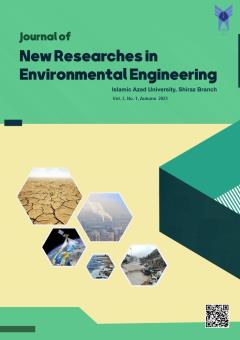Analysis of Kuroshio Current Converter as Renewable and Environmentally Friendly Power Plant
Subject Areas : Energy and environment
1 - department of electrical engineering, Dariun Branch, Islamic Azad University, Dariun, Iran
Keywords: Kuroshio Current converter, reliability, stream speed, fuzzy c-means clustering.,
Abstract :
Introduction: Among different renewable energy sources, ocean is considered as one of the renewable energy sources that has a wide geographical range. Marine currents have different categories that tidal currents are among these currents. Near Japan, there is a current in the ocean known as the Kuroshio Current, which has a high potential for generating electricity. These currents have speed and consequently kinetic energy and can generate electricity by using turbines installed deep in the ocean. One of the problems that these currents have is that they change over time and therefore the power generation of energy converters of Kuroshio currents also varies. Therefore, the effect of these changes on different aspects of these converters such as reliability should be investigated. Materials and Methods: In the reliability model of the current converter, both the component failure and output power variations, which are caused by the change in the speed of ocean currents are considered. Results and Discussion: In this part, a Kuroshio Current energy converter that includes a turbine with a diameter of 2 meters is considered. In this part, the reliability indices of a sample test system are obtained, and then the effect of Kuroshio Current power plants on these indices is evaluated. The results show that as the peak load of the system increases, the reliability of the system deteriorates. Conclusion: In this paper, the reliability model of Kuroshio Current converters is obtained. Numerical results conclude that the Kuroshio Current converters can improve reliability indices of power system.
[1] Tsao, Che-Chih, et al. "Marine current power with cross-stream active mooring: Part I." Renewable Energy 109 (2017): 144-154. https://doi.org/10.1016/j.renene.2017.02.065
[2] Tsao, Che-Chih, et al. "Marine current power with cross-stream active mooring: Part II." Renewable Energy 127 (2018): 1036-1051. https://doi.org/10.1016/j.renene.2018.04.024
[3] Shirasawa, Katsutoshi, et al. "Experimental verification of a floating ocean-current turbine with a single rotor for use in Kuroshio currents." Renewable Energy 91 (2016): 189-195. https://doi.org/10.1016/j.renene.2016.01.035
[4] Liu, Tianran, et al. "High-resolution modeling of the Kuroshio current power south of Japan." Journal of Ocean Engineering and Marine Energy 4 (2018): 37-55. https://doi.org/10.1007/s40722-017-0103-9
[5] Ueno, Tomohiro, et al. "Development and demonstration test for floating type ocean current turbine system conducted in kuroshio current." 2018 OCEANS-MTS/IEEE Kobe Techno-Oceans (OTO). IEEE, 2018. https://doi.org/10.1109/OCEANSKOBE.2018.8558792
[6] Liu, Zhao‐Jun, et al. "Tempo‐spatial variations of the Kuroshio current in the Tokara Strait based on long‐term ferryboat ADCP data." Journal of Geophysical Research: Oceans 124.8 (2019): 6030-6049. https://doi.org/10.1029/2018JC014771
[7] Barnier, Bernard, et al. "Modelling the impact of flow-driven turbine power plants on great wind-driven ocean currents and the assessment of their energy potential." Nature Energy 5.3 (2020): 240-249. https://doi.org/10.1038/s41560-020-0580-2
[8] Kubota, Yoshimi, et al. "Variation in subsurface water temperature and its link to the Kuroshio Current in the Okinawa Trough during the last 38.5 kyr." Quaternary International 452 (2017): 1-11. https://doi.org/10.1016/j.quaint.2017.06.021
[9] Wang, Jia, et al. "The evolution of the Kuroshio Current over the last 5 million years since the Pliocene: Evidence from planktonic foraminiferal faunas." Science China Earth Sciences 63.11 (2020): 1714-1729. https://doi.org/10.1007/s11430-019-9641-9
[10] Taniguchi, Naokazu, et al. "Measuring the Kuroshio Current with ocean acoustic tomography." The Journal of the Acoustical Society of America 134.4 (2013): 3272-3281. https://doi.org/10.1121/1.4818842
[11] Hsu, Po-Chun. "Surface Current Variations and Hydrological Characteristics of the Penghu Channel in the Southeastern Taiwan Strait." Remote Sensing 14.8 (2022): 1816. https://doi.org/10.3390/rs14081816
[12] Ghaedi, Amir, et al. "Toward a comprehensive model of large-scale DFIG-based wind farms in adequacy assessment of power systems." IEEE Transactions on Sustainable Energy 5.1 (2013): 55-63. https://doi.org/10.1109/TSTE.2013.2272947
[13] Ghaedi, Amir, and Hamed Gorginpour. "Reliability evaluation of permanent magnet synchronous generator‐based wind turbines considering wind speed variations." Wind Energy 24.11 (2021): 1275-1293. https://doi.org/10.1002/we.2631
[14] Mirzadeh, Mostafa, Mohsen Simab, and Amir Ghaedi. "Reliability evaluation of power systems containing tidal power plant." Journal of Energy Management and Technology 4.2 (2020): 28-38. https://doi.org/10.22109/jemt.2020.176501.1167
[15] Liu, Mingjun, et al. "Reliability evaluation of a tidal power generation system considering tidal current speeds." IEEE Transactions on Power Systems 31.4 (2015): 3179-3188. https://doi.org/10.1109/TPWRS.2015.2473797
[16] Ghaedi, Amir. "Reliability modelling of ocean current energy conversion systems through both analytical and Monte Carlo methods." Ocean Engineering 286 (2023): 115457. https://doi.org/10.1016/j.oceaneng.2023.115457
[17] Nargeszar, Ayoub, et al. "Reliability evaluation of the renewable energy‐based microgrids considering resource variation." IET Renewable Power Generation 17.3 (2023): 507-527. https://doi.org/10.1049/rpg2.12611


